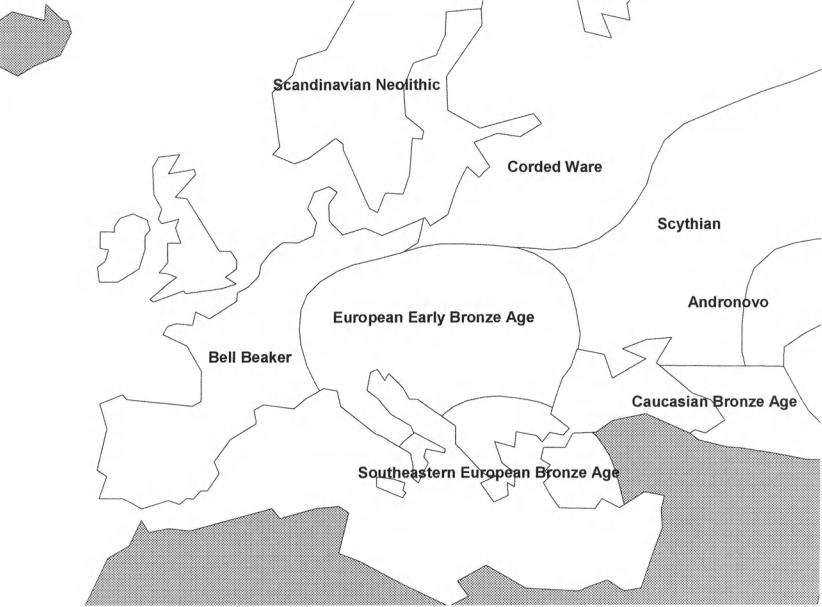
Encyclopedia of Prehistory, Volume 4, Europe
.pdfand conquest seem to also have developed along with metalworking and political centralization, culminating in the rise of the Roman Empire and the conquest of much of the European continent.
The patterns of cultural change evident in Europe speaks to processes of cultural adaptation, economic interaction, and technological innovation that we can only begin to examine today. Europe is perhaps the best known of all the regions of the world covered in the
Encyclopedia of Prehistory, yet the data we have still allow only the slightest glimmer of understanding about these broad patterns and processes of cultural evolution. I hope that ongoing fieldwork, laboratory analyses, and library research with tools such as the
Encyclopedia of Prehistory will soon help us to better understand these important processes of cultural stability and change.
A Word about the Entries
While the above summary may suggest a uniform knowledge of the archaeological record across the entire continent of Europe, nothing could be farther from the truth. Some traditions have been the focus of intensive research, while others have gained the interest of only a few scholars. For example, we know considerably more about Western Europe, even its very early prehistory, than we do about Eastern Europe. The reasons for this variation are often difficult to ascertain, but have to do with physical accessibility, varying degrees of political stability, the personal interests of the researchers, as well as larger questions being asked by the community of archaeologists. As you use the Encyclopedia, bear in mind that some traditions have more and better information than others.
The above summary may also make it appear that the prehistory of Europe can be easily cut up into discrete chunks. It cannot. As we discuss in the Preface to this volume, the units we designed to organize the
Encyclopedia of Prehistory-major archaeological tradi- tions-are to some extent arbitrary, and they are most certainly meaningless in the context of the lives of the prehistoric peoples themselves. They are devices of our
Introduction xxi
creation, in the present day, to make possible the comparative analysis of the peoples of the past. Thus, when I say, for example, that the Solutrean tradition was followed by the Magdelenian tradition, it should not be taken to imply that the break between the two is clear and discrete, or that all people changed in exactly the same ways at precisely the same time. Nor should such a statement imply that there was a population replacement between the two traditions. More importantly, such a statement should not be taken to imply that the peoples of either tradition knew they were living in any sort of unity with other people who we, from our perspective today, suggest they shared a common archaeological tradition.
Any undertaking this massive will face goals that cannot be met. We had hoped to commission many of the entries in this volume from scholars at European universities and research institutes. Unfortunately, the ease of international communication varies dramatically between European nations, and we were unable to solidify arrangements with local scholars in many of the areas discussed above. Thus, the volume is dominated by scholars from the United States and Western Europe. This does not imply that the information they provide is flawed or inadequate, only that we did not achieve our goal of offering local scholars, particularly in Eastern Europe, the chance to describe the prehistory of the regions in which they work.
Also we failed to achieve complete participation from those scholars who did agree to write entries for the Encyclopedia. Conflicting schedules, miscommunication, and unforeseen circumstances forced a number of scholars to miss our deadlines or withdraw from contributing to the Encyclopedia. In those cases I produced (often with generous assistance from other scholars and members of the editorial board) what I call "minimalist" entries which provide basic information on Major Traditions and bibliographical source material for further research. These entries, while checked and approved by regional experts, were not written by an expert, and should, perhaps, be taken less seriously than other entries in the volume.
PETER N. PEREGRINE


S |
Age |
() |
Scythian |
Western European Late Bronze Age
(2) Europe showing major traditions at 3000 B.P.

~
andinavian N
Corded Ware
o
Scythian
Andronovo
European Early Bronze Age
Bell Beaker
(3) Europe showing major traditions at 4000 B.P.

o
~
Corded Ware
rasian Steppe Nomad
o(JtheMtern European Early
E
(4) Europe showing major traditions at 6000 B.P.

o
\S
Eastern European Mesolithic
Western European Mesolithic
(5) Europe showing major traditions at 8000 B.P.




